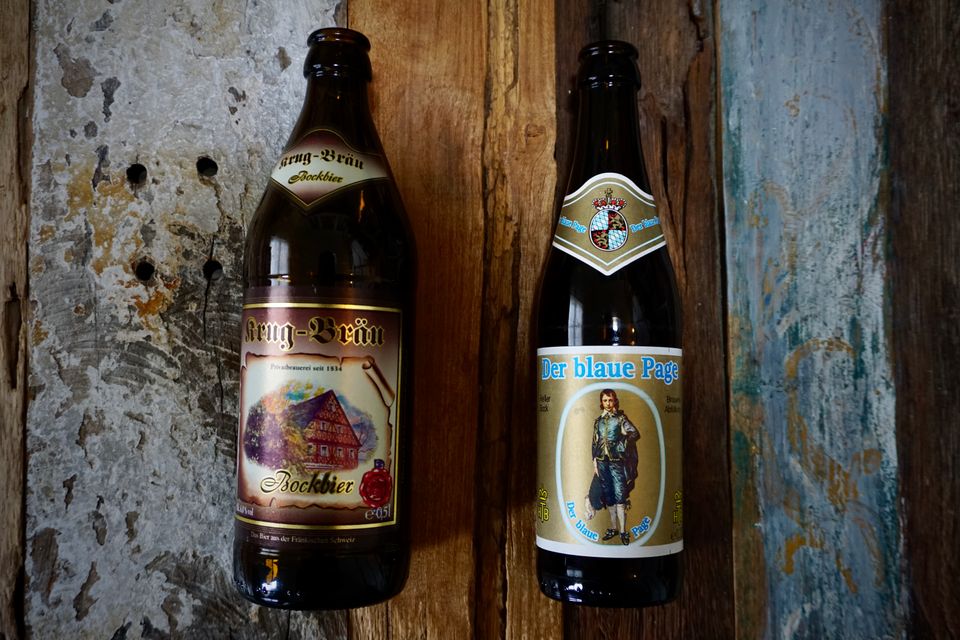Bock to the Future

It's officially spring, and even though it's not quite the month of May, we're breaking out the Maibock. This is a younger sibling in the Bock family - a group usually known for being a bunch of dark, strong, malty lagers. The Maibock differs primarily in colour, and does so by substituting in some lighter Pilsner malt to lessen the effect of the darker Vienna and Munich malts that you'll find dominating the traditional Bock. As such, the name Helles or Heller (light) Bock often shows up on the label. Which does a bit of a disservice to the history behind the Maibock, which was originally brewed for the German springtime festivals in the month of May. I'm a fan of the rarely used Festbock when an alternative name is necessary, but I'm happy enough to accept whatever the brewer sticks on the label.
There's a bit of disagree-confusion-ment on whether or not Maibock and Heller Bock are indeed the same thing. I think most agree that they indeed are, but for the fact that a Maibock brews (sells) well in the springtime, and a Heller Bock brews (sells) well any time of the year. Just take a look at Einbecker - a still operating 14th century (!) brewery - from the city that started it all: Einbeck.
A quick aside: while Bocks may have originated in Einbeck, they wouldn't get their modern name until Bavaria headhunted an Einbeck brewer to brew the style down South. The Bavarians decided that the the locals would have an easier time pronouncing Bock than Beck in their home dialect, and so the Bock was born.
Back to Einbecker, the brewery that has on offer both a Heller Bock (all-year-round) and a Maibock (seasonally). These can't simply be the same beer with a different label on them... can they? Hopefully the answer is no.
There's an idea floating around that Maibocks are more strongly hopped than their simple Heller Bock counterparts, so I thought I'd test it out. I didn't manage to get my mitts on the pair of Einbeckers mentioned above, so I tried my best with another two Bocks that found their way into my fridge.
Krug-Bräu Bockbier
Heller (Mai)Bock | Alc 6.8% | Best before 22.12.2021
Colour
Pale Amber.
Nose
Rich malt, but think multigrain as opposed to white sourdough. There's a depth to this that goes beyond the malt - some floral aspect of the hops just manages to break through. A little bit of caramel when it starts to warm.
Mouth
Lively and crisp - malty but not overbearing. Mostly off-dry throughout with a finish that eventually registers a note of bitter. On warming up: deliciously sweet biscuits and some alcohol.
7/10
Brauhaus Tegernsee | Der blaue Page
Heller Bock | Alc 6.8% | Best before 2.11.2021
Colour
Straw.
Nose
The classic German Helles aromas paired with some tomatoes on-the-vine.
Mouth
This went flat quick as a pancake and in doing so lost any chance at vibrancy or freshness. A comparably light malt profile when compared with the above. Some biscuit is present but very little lingers into the finish.
3/10
These struck very different chords with me. The Krug-Bräu comes across as complex, fresh and alive, while the Tegernsee comes across as flat, dull and dead. The dark-er or doppel-er Bocks have never resonated with me because I can't find my way into liking all that malt without something to offset it. Somehow, though, I'm prepared to accept that things like this Krug-Bräu may not be so bad. The malt is present, but not overwhelming. It's matched by the slightest undertone of hoppy bitterness that comes across as a freshness to counter the malt. I'll be careful to let it warm up again though - I didn't enjoy the alcohol making a name for itself, or the malt descending into sweet territory.
This tasting suggests that there might just be something to the Maibocks are different to Heller Bocks story. Then again, we're comparing two different breweries' takes on the style (I'll also give Tegernsee the benefit of the doubt and assume that my bottle wasn't in peak condition), so we could just as easily put it down to that.
jay
